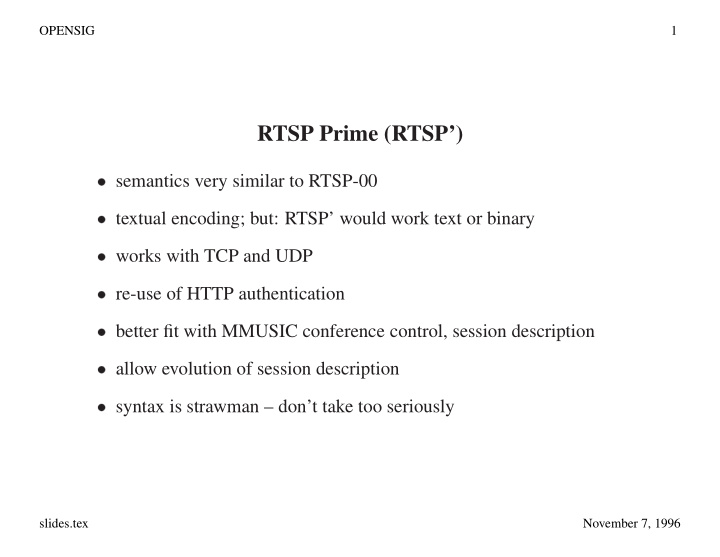



OPENSIG 1 RTSP Prime (RTSP’) � semantics very similar to RTSP-00 � textual encoding; but: RTSP’ would work text or binary � works with TCP and UDP � re-use of HTTP authentication � better fit with MMUSIC conference control, session description � allow evolution of session description � syntax is strawman – don’t take too seriously slides.tex November 7, 1996
OPENSIG 2 Media Server Operation “Traditional” media-on-demand server – live or stored media: 1. RTSP’, HTTP: client retrieves session description, including multicast address (if applicable) 2. client picks desirable stream combination, indicates unicast port 3. RTSP’: client sets port, speed, ... 4. RTSP’: client issues PLAY, ...requests for individual media or session 5. server can announce new media (for live sessions) 6. RTSP: client or server says BYE slides.tex November 7, 1996
OPENSIG 3 Media Server in Conference 1. S*IP?: conference participant (CP) invites server e.g.: play audio into existing multicast session session establishment outside scope (e.g., H.323) session description in invitation server joins group and waits for commands 2. RTSP’: GET description (language, content, but not address) 3. RTSP’: CP sets parameters, controls playout slides.tex November 7, 1996
OPENSIG 4 Naming � URL-like name for session and individual components: host/session/media movies.microsoft.com/twister/audio_en#11:12 slides.tex November 7, 1996
OPENSIG 5 Example: join a broadcast C->S GET twister S->C 200 OK session description (media (m audio 224.2.0.1 3456) (id audio_en)) C->S PLAY twister/audio_en slides.tex November 7, 1996
OPENSIG 6 Example: unicast media server C->S GET twister S->C 200 OK (media (m audio) C->S PORT 48484 PLAY twister/audio_en denial-of-service attack ➠ only to address of request slides.tex November 7, 1996
OPENSIG 7 Example invitation to conference Client ! server: S*IP invitation -> conference id GET twister 17 Conference: conference identifier S ! C: 200 17 OK Content-type: application/sdf ... (media (audio ...) (language en/us) (id audio_en) (media (video ...) (id video) C ! S: PLAY twister/audio_en Content-range: 0:5:6.0 slides.tex November 7, 1996
OPENSIG 8 PLAY twister/video SET_SPEED twister Speed: 0.5 slides.tex November 7, 1996
OPENSIG 9 Camera Control ➠ just more commands difficulty: naming (several cameras attached to host) PAN camera1 Angle: 125 slides.tex November 7, 1996
OPENSIG 10 RTSP’ (textual) over TCP � simply delineate requests: blank line after header, content-length for session description, etc. � embed RTP, RTCP, text, ...packets using content-length slides.tex November 7, 1996
OPENSIG 11 RTSP’ over UDP � several commands in one packet � sequence number (per packet) for reliability � RTT ➠ retransmission = different seq. # slides.tex November 7, 1996
OPENSIG 12 Other RTSP Issues � parameter settings: advantage of second level not clear � separate issue: who gets to control ➠ floor control or social protocol � request for report should be in RTCP (with sampling option for large groups) � retransmission should be in RTCP ➠ already there for H.261! � difference between PAUSE and STOP? RSVP? slides.tex November 7, 1996
OPENSIG 13 Session Description � current SDP is compact, but not good for structure � ➠ re-use much of SDP coding, but add structure � easy inheritance of parameters all: play all list elements concurrently one-of: pick one the list elements sequence: play list elements sequentially Parameters: at any level; globally unique names? slides.tex November 7, 1996
OPENSIG 14 SDF (session (v 0) (o mhandley 2890844526 2890842807 IN IP4 126.16.64.4) (s Sd seminar) (i A seminar on the session description protocol) (u http://www.cs.ucl.ac.uk/staff/M.Handley/sdp.01.ps) (e M.Handley@cs.ucl.ac.uk (Mark Handley)) (c IN IP4 224.2.17.12/127)(t 2873397496 2873404696)(a r (all (media (m audio 3456 RTP ( (one-of ((enc PCMU) (id Foo)) ((enc DVI) (id Bar)) ) (media (m video 2232 RTP H261) (id Pix)) (media (m whiteboard 32416 UDP WB)(orient portrait)) )) slides.tex November 7, 1996
Recommend
More recommend